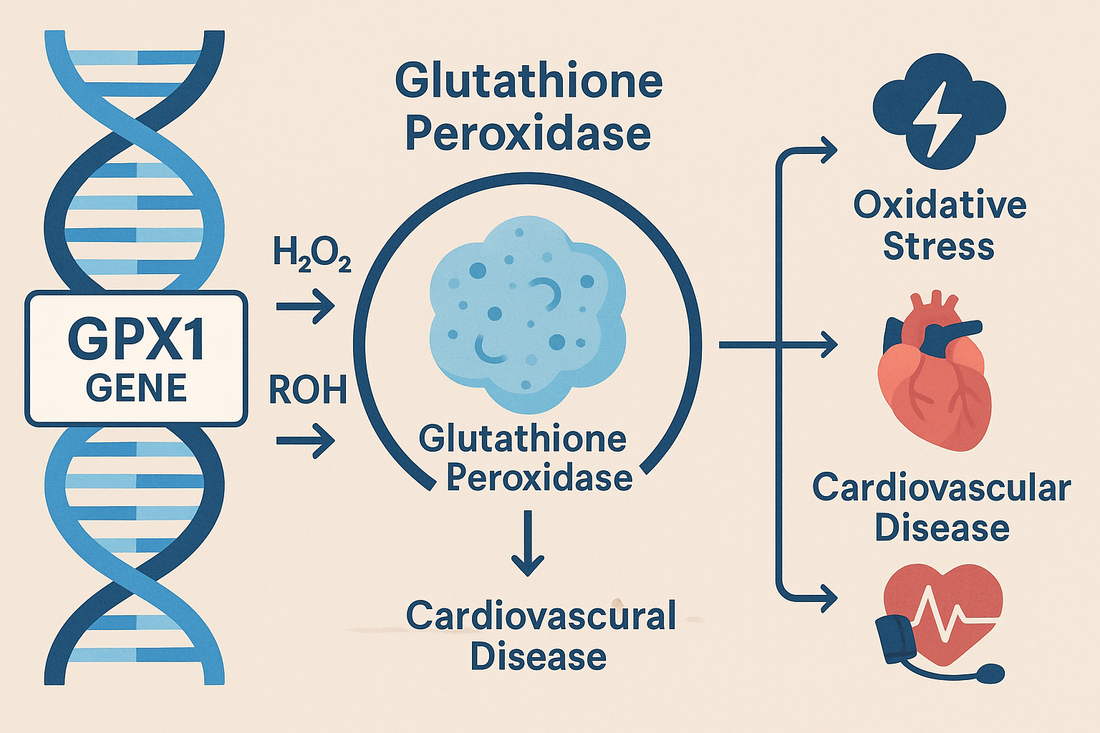GPX1 (Glutathione Peroxidase, GSHPx) Gene Variants and Cardiovascular Disease
Introduction
The GPX1 gene, also known as GSHPx, encodes glutathione peroxidase 1, a selenium-dependent enzyme critical for detoxifying peroxides and reducing oxidative stress. Located on chromosome 3p21.3, GPX1 protects vascular endothelium from oxidative injury and maintains cardiovascular health.
Variants in GPX1 can impair antioxidant defenses, leaving blood vessels more vulnerable to oxidative stress, inflammation, hypertension, and atherosclerosis. CardiaX testing includes GPX1 polymorphisms because they provide insight into oxidative stress susceptibility and long-term cardiovascular disease (CVD) risk.
GPX1 Function in the Body
-
Antioxidant defense: Catalyzes the reduction of hydrogen peroxide (H₂O₂) and lipid peroxides using glutathione.
-
Endothelial protection: Prevents oxidative injury to vascular lining.
-
Anti-inflammatory role: Reduces NF-κB activation and pro-inflammatory cytokines.
-
Mitochondrial support: Protects mitochondrial membranes from oxidative damage.
Key GPX1 Variants
rs1050450 (Pro198Leu)
-
Leu allele carriers: Reduced GPX1 activity, increased oxidative stress.
-
Clinical impact: Associated with higher risk of hypertension, coronary artery disease, and stroke.
rs1800668
-
Linked with lower enzyme activity and increased cardiovascular risk in some populations.
How GPX1 Variants Contribute to Cardiovascular Disease
-
Hypertension: Increased ROS (reactive oxygen species) reduce nitric oxide (NO), impairing vasodilation.
-
Endothelial dysfunction: Oxidative damage accelerates vascular inflammation.
-
Atherosclerosis: Lipid peroxidation promotes plaque formation and instability.
-
Ischemic events: Elevated oxidative stress increases clotting risk and vascular injury.
What Worsens Risk in GPX1 Variants?
-
Low selenium intake: Essential cofactor for GPX1 activity.
-
High oxidative stress states: Smoking, pollution, heavy alcohol use.
-
Metabolic syndrome & diabetes: Increase ROS burden.
-
Sedentary lifestyle: Reduces antioxidant defense systems.
-
Poor diet: Low intake of antioxidants (vitamins C, E, polyphenols).
How to Mitigate GPX1-Associated Risk
1. Lifestyle Strategies
-
Diet:
-
Increase selenium-rich foods: Brazil nuts, seafood, eggs.
-
Follow an antioxidant-rich Mediterranean diet with fruits, vegetables, olive oil, and nuts.
-
Reduce processed foods and fried oils to limit lipid peroxidation.
-
-
Exercise: Moderate physical activity upregulates antioxidant enzyme expression.
-
Avoid smoking & excessive alcohol: Both deplete GPX1 activity.
2. Nutraceuticals
-
Selenium (100–200 mcg/day): Essential for GPX1 enzyme activity.
-
Omega 1300 — Omega 1300: Anti-inflammatory, protects vascular membranes.
-
CoQ10 Omega — CoQ10 Omega: Enhances mitochondrial protection against oxidative damage.
-
Curcumin Complex — Curcumin Complex: Potent antioxidant and anti-inflammatory.
-
Vitamin C & Vitamin E: Scavenge ROS and regenerate glutathione.
-
N-acetylcysteine (NAC): Boosts glutathione levels, supporting GPX1 activity.
3. Peptides
-
MOTS-c: Enhances mitochondrial efficiency and antioxidant defense.
-
BPC-157: Supports vascular healing under oxidative stress.
-
SS-31: Protects mitochondria from ROS-mediated injury.
4. Medications
-
Statins: Provide pleiotropic antioxidant and anti-inflammatory benefits.
-
ACE inhibitors/ARBs: Improve endothelial function and reduce ROS burden.
-
SGLT2 inhibitors / GLP-1 agonists: Reduce oxidative stress in diabetic patients.
-
Antiplatelets: Lower clotting risk associated with endothelial dysfunction.
Case Example
A 55-year-old female with GPX1 rs1050450 CT genotype (Pro/Leu) presents with hypertension and a family history of stroke. Diet high in processed foods, low in antioxidants.
Plan:
-
Lifestyle: Mediterranean diet, daily walking, quit smoking.
-
Supplements: Selenium, Omega 1300, CoQ10 Omega, Curcumin Complex, NAC.
-
Peptides: MOTS-c for mitochondrial function, SS-31 for oxidative stress protection.
-
Medications: Low-dose ACE inhibitor for BP, statin for vascular support.
Outcome: After 5 months, BP decreased, hsCRP reduced, and oxidative stress biomarkers improved.
The Bottom Line
The GPX1 gene (GSHPx) is a cornerstone of antioxidant defense in the cardiovascular system. Variants reduce enzyme efficiency, leading to oxidative stress, hypertension, and vascular injury.
Through CardiaX testing, clinicians can identify at-risk individuals and implement dietary, nutraceutical, peptide, and medication-based interventions to strengthen antioxidant defenses and lower cardiovascular risk.
References
-
Bermano G, et al. GPX1 polymorphisms and cardiovascular disease. Free Radic Biol Med. 2007.
-
Meplan C, et al. Genetic variants in glutathione peroxidase and risk of hypertension. Hypertension. 2010.
-
Lubos E, et al. Role of oxidative stress in endothelial dysfunction and GPX1 activity. Circulation. 2011.
-
Rayman MP. Selenium and human health. Lancet. 2012.


